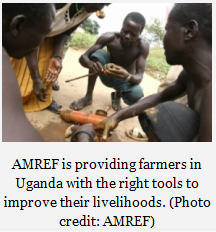 Katine is one of the poorest villages in the district of Soroti, in north eastern Uganda. For the 25,000 people living in Katine, their livelihood depends on cultivating cassava, ground nuts, millet, and sweet potatoes. Many farmers are not growing enough crops to sell and can’t afford to spend money on education or medication.
Katine is one of the poorest villages in the district of Soroti, in north eastern Uganda. For the 25,000 people living in Katine, their livelihood depends on cultivating cassava, ground nuts, millet, and sweet potatoes. Many farmers are not growing enough crops to sell and can’t afford to spend money on education or medication.
In 2007, The African Medical and Research Foundation (AMREF) partnered with the Guardian newspaper and Barclays Bank to establish a four year long project aimed at improving the overall livelihood of villagers in Katine. When the project began, malaria was responsible for nearly a quarter of deaths in the village, and 57.7 percent of children under five had malaria.
And most villagers did not have enough money to get health services or buy malaria medication. Malnutrition and stunted growth were also common—most villagers ate only one meal a day and their diets lacked protein. Food insecurity also impacted education—because many students had to leave school to help their family farm or take care of siblings while their parents farmed, the dropout rate was 19 percent for boys and 22 percent for girls.
To address the root causes of health and education problems, AMREF worked with farmers to increase their incomes so that they could afford to send their kids to school and protect their families from disease. The project identified a number of challenges that farmers in Katine face, including sporadic rainfall resulting from the effects of climate change, poor soil fertility, the lack of crop diversity, and the need to increase farmer’s access to markets. These challenges lead to both economic insecurities and problems with villagers’ diets. To increase farm productivity, AMREF worked with CARE and Farm-Africa to provide technical support to farmers. They set up farming schools to train villagers to improve soil fertility, conserve water, and control pests. Techniques that farmers learned included integrated pest management and digging water channels to capture water for agricultural use. Farmers also learned how to grow different crops together in order to increase crop yield. Through this technique, known as intercropping, farmers learned to plant legumes with rice, helping increasesoil fertility by enriching the soil with nitrogen. It is estimated that the training program will directly help 2,000 households.
Farmers also set up a farming cooperative that combined 66 rural innovation groups into the Katine Joint Farmers Association (KAJOFA). The cooperation worked with government agencies, including the National Agriculture Advisory Service, to help farmers grow new varieties of crops, including drought resistant cassava, which helped villagers survive when the region experienced a famine in 2009.
AMREF also helped farmers sell their products. They established a produce store located on a road that connects Uganda to Sudan. Farmers also gained support from village saving and loans groups that were established to help villagers save their money. Through these groups, farmers received money to help them purchase agricultural inputs including machines and fertilizers. Lastly, in order to ensure the safety of livestock, a drug store was set up to supply cattle herders with medication for their cattle.
By helping farmers increase productivity, AMREF has helped villagers in Katine start working towards a better future. Villagers have already experienced changes in their quality of health and education as a result of greater income stability. Finishing its final year, the project has helped to immunize more than 15,500 children against diseases and the percentage of children under five who have contracted malaria has dropped to 54.9 percent. Additionally, school enrollment has gone up. Agriculture has also been integrated into the curriculum—6,000 trees and citrus seedlings were provided to schools for them to teach students about growing fruit. The fruit from the trees also provides students with nutrition during the school day. Students believe that the fruit tree program is helping, “”when I am hungry, I feel like I want to go to sleep”, explains Patricia Asio,a primary school student in Katine. “ It is a big difference to have food,” Patricia concludes.
Graham Salinger is a research interns for the Nourishing the Planet project.

Danielle Nierenberg, an expert on livestock and sustainability, currently serves as Project Director of State of World 2011 for the Worldwatch Institute, a Washington, DC-based environmental think tank. Her knowledge of factory farming and its global spread and sustainable agriculture has been cited widely in the New York Times Magazine, the International Herald Tribune, the Washington Post, and
other publications.
Danielle worked for two years as a Peace Corps volunteer in the Dominican Republic. She is currently traveling across Africa looking at innovations that are working to alleviate hunger and poverty and blogging everyday at Worldwatch Institute’s Nourishing the Planet. She has a regular column with the Mail & Guardian, the Kansas City Star, and the Huffington Post and her writing was been featured in newspapers across Africa including the Cape Town Argus, the Zambia Daily Mail, Coast Week (Kenya), and other African publications. She holds an M.S. in agriculture, food, and environment from Tufts University and a B.A. in environmental policy from Monmouth College.








